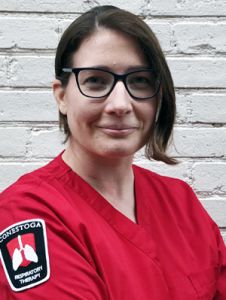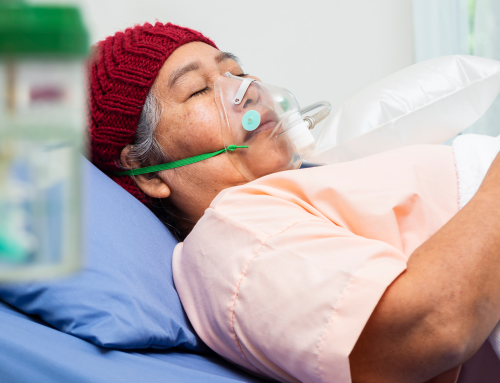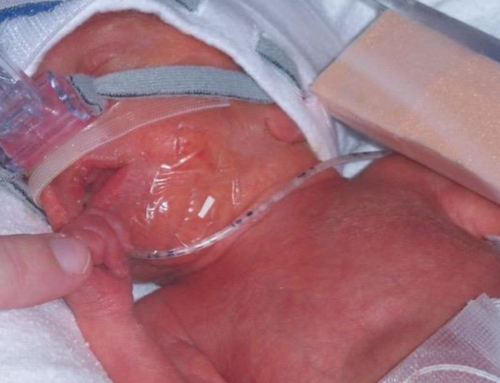
Submitted by: Amanda Niederkorn, MSc SRT, Conestoga College
Obstructive sleep apnea (OSA) is a serious breathing disorder that occurs when someone experiences complete or partial airway obstruction during sleep (Public Health Agency of Canada, 2010). When left undertreated, OSA negatively impacts patient health and contributes to socioeconomic and population-level health care burdens (Benjafield et al., 2019; Laratta et al., 2017; Pendharkar et al., 2017; Rotenberg et al., 2010; Wickwire et al., 2020).
In 2019, Benjafield and colleagues published the first meta-analysis on the global prevalence of OSA. This study reported 501 million adults aged 30-69 years have been diagnosed with mild-moderate OSA (apnea-hypopnea index, AHI, greater than 5 per hour, 5/hr) and a further 435 million people have moderate-severe OSA (AHI, greater than15/hr). These figures are suspected to be underestimates due to the lack of available data and inconsistent metrics used during diagnosis (Benjafield et al., 2019). In order to develop effective management practices and mitigate the health complications associated with OSA, this basic epidemiological data is required (Benjafield et al., 2019; Laratta et al., 2017). In this meta-analysis Benjafield et al. (2019) emphasizes the importance for countries to continue – or to start – collecting quality population and national level data. Canada is an example of a country that could significantly improve current OSA monitoring and reporting.
In 2009, the Sleep Apnea Rapid Response Questionnaire (SARP) completed by Statistics Canada as part of the Canadian Community Health Survey was the first national estimate of sleep apnea (Public Heath Agency of Canada, 2011). Self-reported data from 8 647 Canadians was extrapolated to estimate 3% of the population have been professionally diagnosed with sleep apnea, and almost 30% of Canadians are at a high risk of developing sleep apnea (Public Heath Agency of Canada, 2011). It’s important to note that this survey excluded all northern territories, aboriginal settlements and members of the Canadian Forces. To my knowledge, the SARP survey has not been duplicated and participants were not involved in any follow-up studies. A small subset of data from the Canadian Community Health Survey during the 2016-2017 cycle is now available, with the main sleep apnea questions limited to age, gender and OSA risk factors (obesity, hypertension, neck circumference) (Statistics Canada, 2018). Overall, to improve the current state of Canadian OSA data, research should focus on: long-term studies; objective data collection (not self-reported); larger sample sizes; evaluation of long-term treatment outcomes; and data management plans that consist of accessible (use common global metrics for OSA) and interoperability data.
Evans et al. (2014) utilized the 2009 SARP data to find 23% of Canadians were diagnosed with sleep apnea without overnight polysomnography testing in a sleep laboratory – a test recommended by the Canadian Thoracic Society for not only diagnosis but also for the long-term monitoring of OSA. A possible explanation to why many Canadians are not referred for polysomnography testing is the scarcity of publicly funded (or even privately funded) sleep laboratories in many regions (Pendharkar et al., 2017; Povitz et al., 2019). The ratio of testing beds in Canada is 2 per 100,000 people; the highest ratio being found in Ontario (4.1 beds per 100,000 people) and the lowest ratio found in the Yukon (0 beds) (Evans et al., 2014). On top of sleep specialists being in short supply, many Canadians are not able to overcome the financial burden of accessing these sleep clinics (Rotenberg et al., 2010). Therefore, if current Canadian prevalence values (from the 2009 SARP survey) are based on “professionally-diagnosed” cases, there is a significant chance the current values are considerable underestimates.
In addition to barriers in diagnostic times, Canadians also experience significant delays in initiating treatment. The cost of initial treatment with a continuous positive airway pressure (CPAP) device can range from 1500-2800$ and treatment with oral appliances range from 400-3000$ (Pendharkar et al., 2017). Publicly funded treatment (partial or complete coverage) can be found in Manitoba, Ontario and Saskatchewan (Pendharkar et al., 2017). Consumable items such as CPAP masks and tubing are often not covered in these provinces (Pendharkar et al., 2017). A recent study by Povitz et al. (2019) used billing information for 216 514 Canadians and reported less than 70% of Canadians begin CPAP treatment within 6 months of diagnosis. These wait times are in contrast to the recommendations put forth by the Canadian Thoracic Society who recommend a 4-week wait for patients with severe OSA presenting with comorbid conditions and a maximum wait of 6 months for all other patients (Fleetham et al., 2011). Lengthy wait times are concerning when you consider patients with OSA are at a greater risk of motor vehicle collisions, are twice as likely to be involved in work related injuries, and are at an independently higher risk of stroke and death (Allen et al., 2016; George, 2004; Yaggi et al., 2005).
As outlined above, current funding models for the diagnosis and treatment of OSA vary considerably across Canada even though it has been shown that early OSA interventions reduce annual healthcare costs (Pendharkar et al., 2017). A Canadian study found OSA patients (n= 382) used healthcare services at an increasing rate almost double that of the control group before they were diagnosed and treated with CPAP (Albarrak et al., 2005). Similarly, Medicare patients (n= 287 191) in the United States with untreated OSA consistently had higher annual heath care costs 5-10 years before initiating treatment (Wickwire et al., 2020). The decrease in health care utilization can be partially contributed to CPAP treatment improving common sequela such as systemic hypertension, vascular disease, cognitive deficiencies, and metabolic syndromes (Sharma et al., 2011). An efficient funding model shouldn’t unnecessarily prescribe treatment and tests, but rather provide care and allocate health care resources appropriately (Pendarker et al., 2017). While developing patient-centered and cost-effective models we should consider the use of preliminary tests (before the more expensive polysomnography), such as the possibility of identifying OSA genetic or molecular markers, the use of machine learning models to understand the clinical progression in different age groups and genders, and most importantly, we should eliminate the AHI metric which does not adequately encapsulate the different symptoms and clinical presentations of OSA (Pendarker et al., 2017; Zinchuk et al., 2017).
There are many confounding factors related to the development, diagnosis and treatment of OSA. This short review only touched on some of these topics. Overall, from the review of the recent literature, I believe all Canadians should have affordable access to OSA care regardless of their home address. It is also important for Student Respiratory Therapists to understand the barriers some patients experience when it comes to OSA and to advocate for patient well-being and evidence-based care.
References
Albarrak, M., Banno, K., Sabbagh, A. A., Delaive, K., Walld, R., Manfreda, J., & Kryger, M. H. (2005).
Utilization of healthcare resources in obstructive sleep apnea syndrome: a 5-year follow-up study in men using CPAP. Sleep, 28 (10), 1306-1311. doi:10.1093/sleep/28.10.1306
Allen, A. H., Park, J. E., Daniele, P. R., Fleetham, J., Ryan, C. F., & Ayas, N. T. (2016).
Obstructive sleep apnoea and frequency of occupational injury. Thorax, 71 (7), 664-666.
Benjafield, A. V., Ayas, N. T., Eastwood, P. R., Heinzer, R., Ip, M. S., Morrell, M. J., Nunez, C.M., Patel, S.R., Pepin, J.D., Peppard, P.E., Sinha, S., Tufik, S., Valentine, K., & Malhotra, A. (2019).
Estimation of the global prevalence and burden of obstructive sleep apnoea: a literature-based analysis. The Lancet Respiratory Medicine, 7 (8), 687-698. doi:10.1016/S2213-2600(19)30198-5
Edwards, B. A., Redline, S., Sands, S. A., & Owens, R. L. (2019).
More than the sum of the respiratory events: personalized medicine approaches for obstructive sleep apnea. American Journal of Respiratory and Critical Care Medicine, 200 (6), 691-703. doi:10.1164/rccm.201901-0014TR
Evans, J., Skomro, R., Driver, H., Graham, B., Mayers, I., McRae, L., Reisman, J., Rusu, C., To, T., & Fleetham, J. (2014).
Sleep laboratory test referrals in Canada: sleep apnea rapid response survey. Canadian Respiratory Journal, 21 (1), e4-e10. doi:10.1155/2014/592947
Fleetham, J., Ayas, N., Bradley, D., Fitzpatrick, M., Oliver, T. K., Morrison, D., Ryan, F., Series, F., Skomro, R., & Tsai, W. (2011).
Canadian Thoracic Society 2011 guideline update: diagnosis and treatment of sleep disordered breathing. Canadian Respiratory Journal, 18 (1), 25-47. doi:10.1155/2011/506189
George, C.F.P. (2004).
Sleep 5: Driving and automobile crashes in patients with obstructive sleep apnoea/hypopnoea syndrome. Thorax, 59 (9), 804-807. doi:10.1136/thx.2003.007187
Laratta, C. R., Ayas, N. T., Povitz, M., & Pendharkar, S. R. (2017).
Diagnosis and treatment of obstructive sleep apnea in adults. CMAJ, 189 (48), E1481-E1488. doi:10.1503/cmaj.170296
Pendharkar, S. R., Povitz, M., Bansback, N., George, C. F., Morrison, D., & Ayas, N. T. (2017).
Testing and treatment for obstructive sleep apnea in Canada: funding models must change. CMAJ, 189 (49), E1524-E1528. doi:10.1503/cmaj.170393
[printfriendly]





